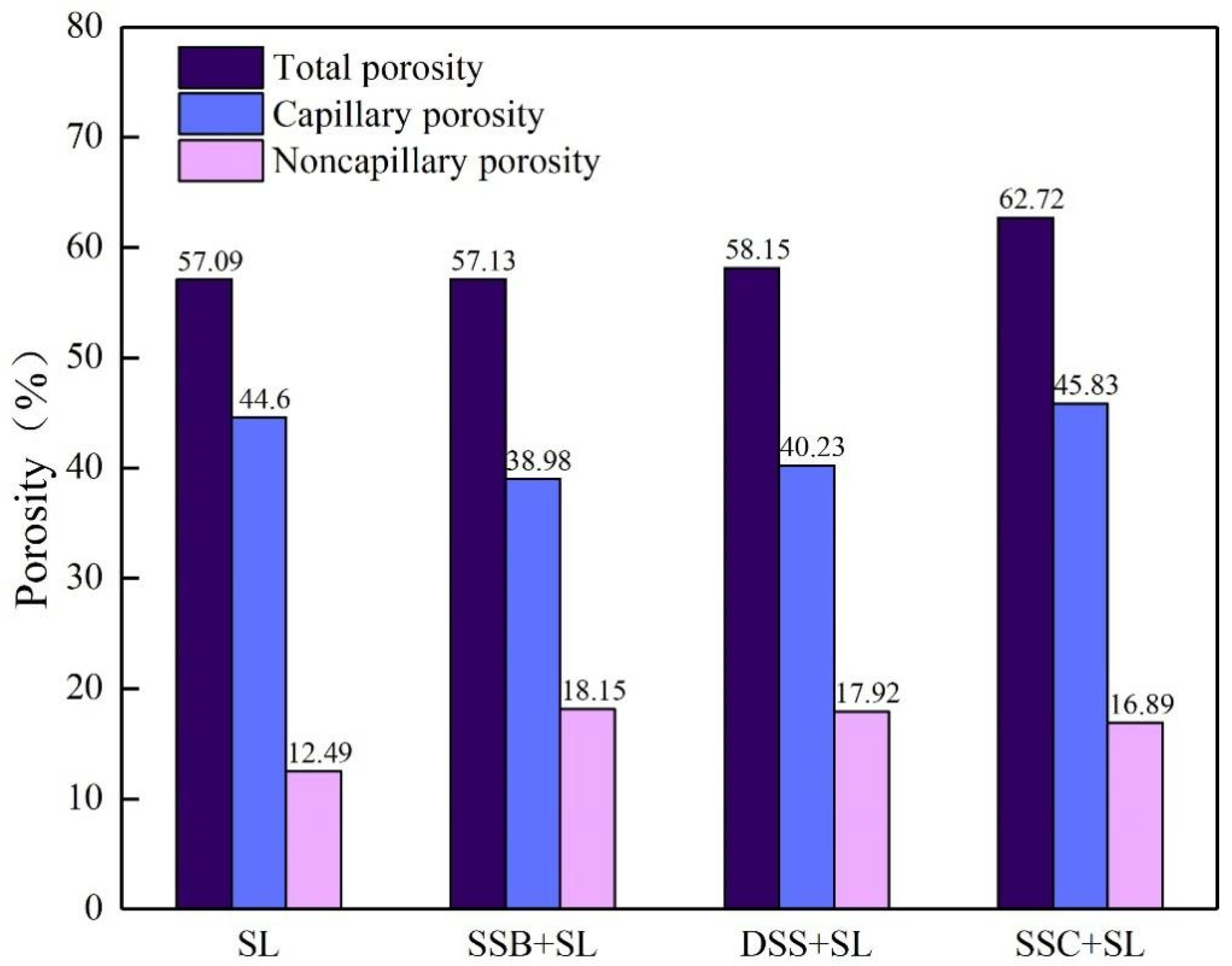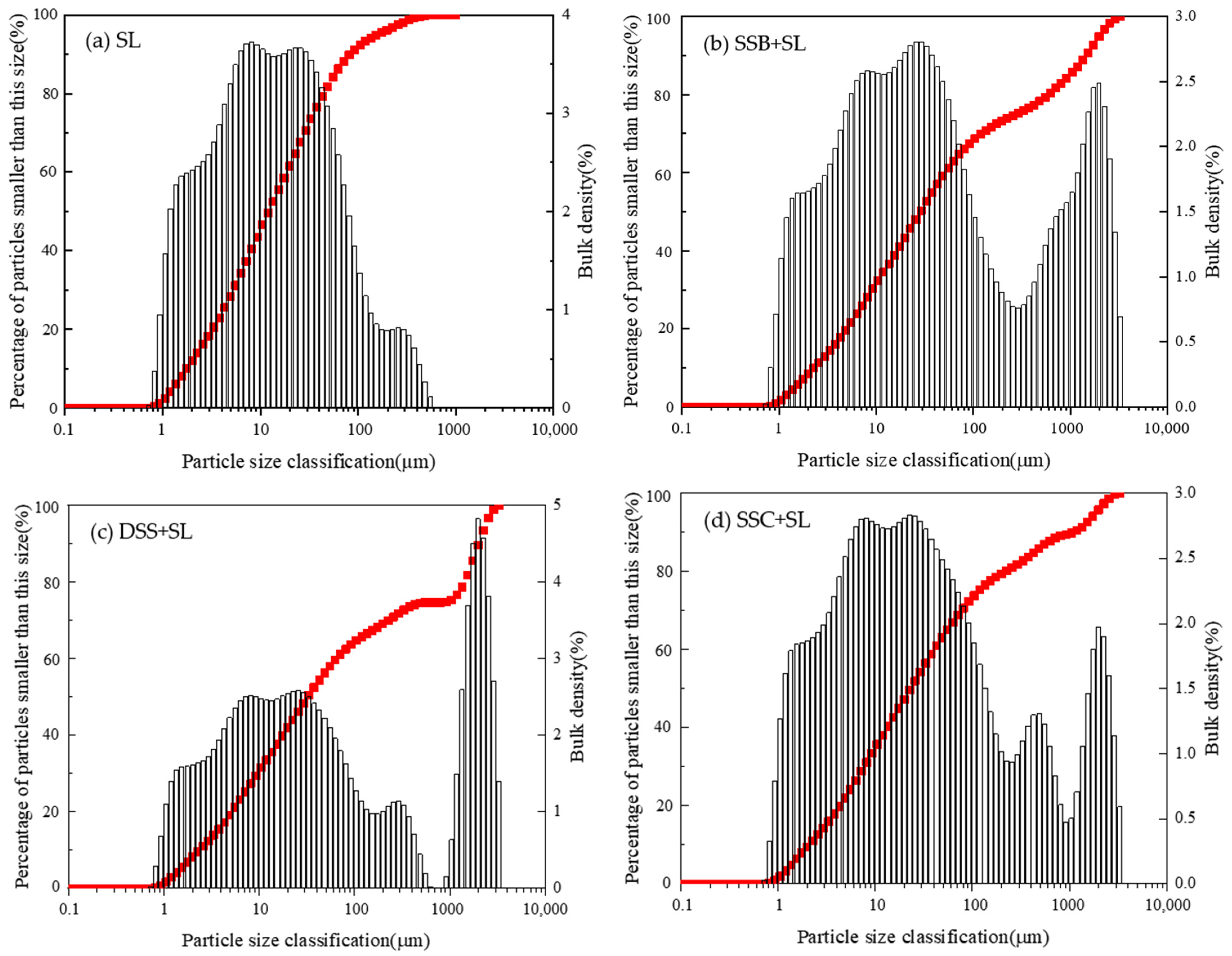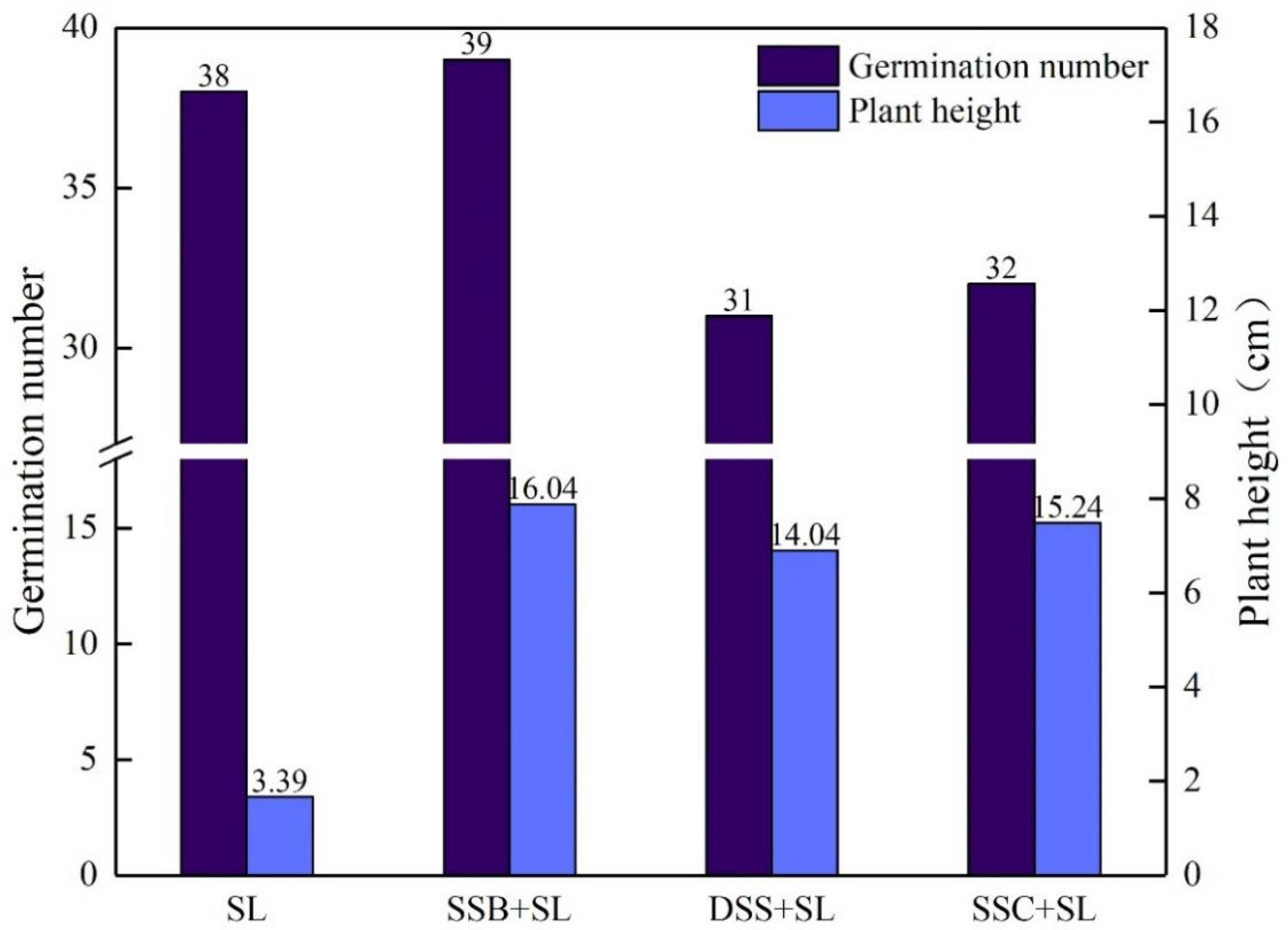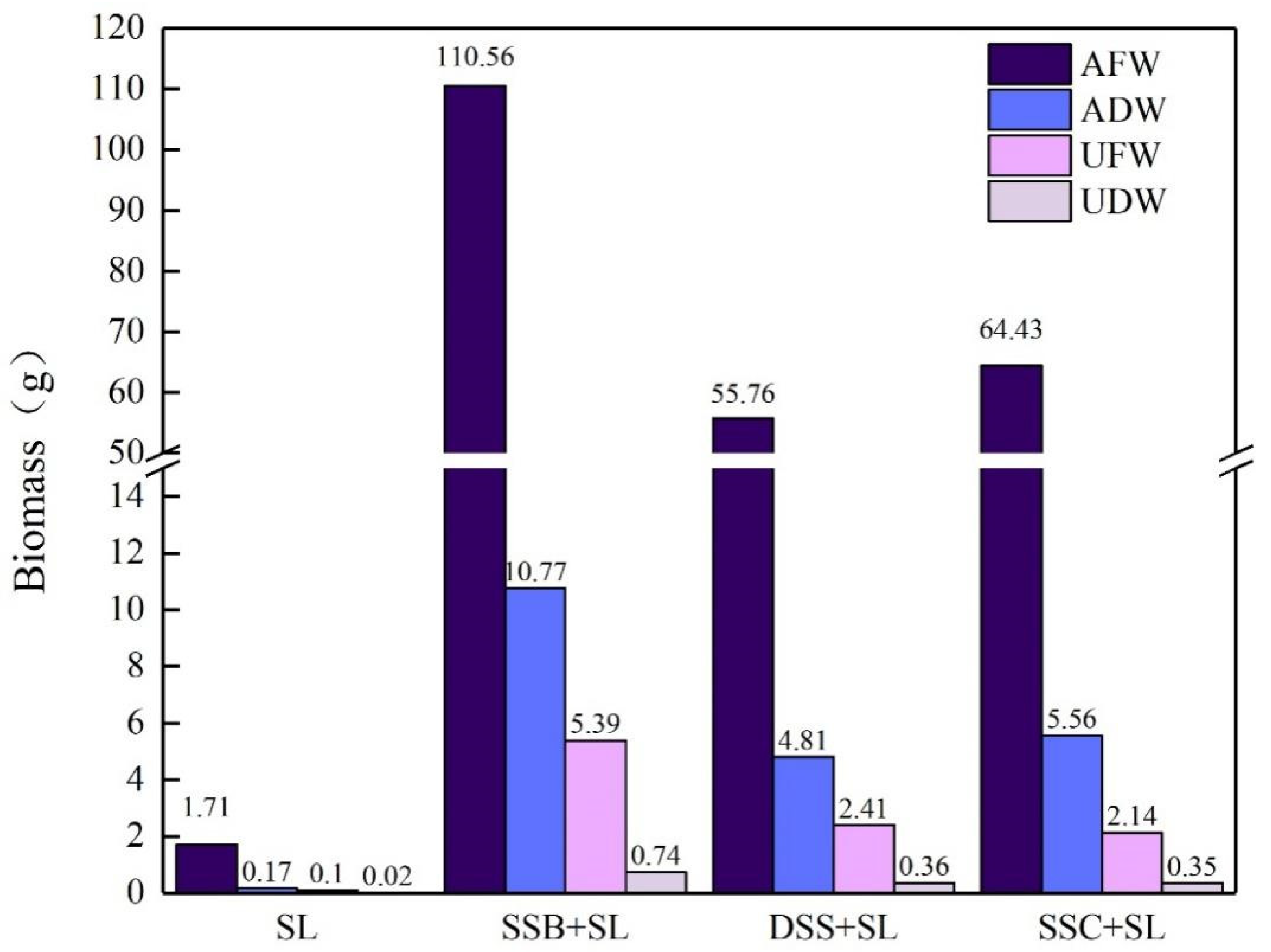Effects of Three Sludge Products from Co-Treatment of Wastewater on the Soil Properties and Plant Growth of Silty Loam
Abstract
:1. Introduction
2. Materials and Methods
2.1. Material Properties
2.2. Preparation of the Pot Experiment
2.3. Determination of Soil Physical Properties
2.4. Determination of Soil Chemical Properties
2.5. Heavy Metal Stability Experiment
2.6. Measurements of Plant Growth Indices
3. Results
3.1. Effect of Three Sludge Products on the Chemical Properties of SL
3.2. Effect of Three Sludge Products on the Physical Properties of SL
- (1)
- Water retention capacity and porosity
- (2)
- Soil aggregates and mechanical composition
3.3. Effects of Three Sludge Products on Plant Growth and Development
3.4. Stability of Heavy Metals in SSB
4. Conclusions
Author Contributions
Funding
Institutional Review Board Statement
Informed Consent Statement
Data Availability Statement
Acknowledgments
Conflicts of Interest
References
- Czapluk, B.; Rutkowski, R.; Rybak, J. Microfauna Composition of Activated Sludge in Domestic and Industrial Sewage Activated Sludge Systems. Environ. Prot. Eng. 2018, 44, 153–166. [Google Scholar] [CrossRef]
- Dai, C.-Y.; Wu, J.; Xiang, X.; Xie, C.-B.; Yin, D.-D.; Cao, Z.-P.; Lü, Q. Fluorescence Properties of Municipal Wastewater with Industrial Wastewater as Major Components. Spectrosc. Spectr. Anal. 2013, 33, 414–417. [Google Scholar]
- Kominko, H.; Gorazda, K.; Wzorek, Z. The Possibility of Organo-Mineral Fertilizer Production from Sewage Sludge. Waste Biomass Valoriz. 2017, 8, 1781–1791. [Google Scholar] [CrossRef] [Green Version]
- Pavšič, P.; Mladenovič, A.; Mauko, A.; Kramar, S.; Dolenec, M.; Vončina, E.; Vrtač, K.P.; Bukovec, P. Sewage sludge/biomass ash based products for sustainable construction. J. Clean. Prod. 2014, 67, 117–124. [Google Scholar] [CrossRef]
- Sharma, B.; Sarkar, A.; Singh, P.; Singh, R.P. Agricultural utilization of biosolids: A review on potential effects on soil and plant grown. Waste Manag. 2017, 64, 117–132. [Google Scholar] [CrossRef]
- Chu, S.; Jacobs, D.F.; Liao, D.; Liang, L.L.; Wu, D.; Chen, P.; Lai, C.; Zhong, F.; Zeng, S. Effects of landscape plant species and concentration of sewage sludge compost on plant growth, nutrient uptake, and heavy metal removal. Environ. Sci. Pollut. Res. 2018, 25, 35184–35199. [Google Scholar] [CrossRef]
- Devi, P.; Saroha, A.K. Risk assessment and technical feasibility of usage of paper mill sludge biochar-based exhausted adsorbent for geopolymeric brick formation. Environ. Sci. Pollut. Res. 2016, 23, 21641–21651. [Google Scholar] [CrossRef]
- Bogusz, A.; Oleszczuk, P. Effect of biochar addition to sewage sludge on cadmium, copper and lead speciation in sewage sludge-amended soil. Chemosphere 2020, 239, 124719. [Google Scholar] [CrossRef]
- Cristina, G.; Camelin, E.; Pugliese, M.; Tommasi, T.; Fino, D. Evaluation of anaerobic digestates from sewage sludge as a potential solution for improvement of soil fertility. Waste Manag. 2019, 99, 122–134. [Google Scholar] [CrossRef]
- Zhang, Z. Drainage Engineering; China Architecture & Building Press: Beijing, China, 2015; Volume II. (In Chinese) [Google Scholar]
- Schulz, H.; Glaser, B. Effects of biochar compared to organic and inorganic fertilizers on soil quality and plant growth in a greenhouse experiment. J. Plant Nutr. Soil Sci. 2012, 175, 410–422. [Google Scholar] [CrossRef]
- Velghe, I.; Carleer, R.; Yperman, J.; Schreurs, S. Study of the pyrolysis of sludge and sludge/disposal filter cake mix for the production of value added products. Bioresour. Technol. 2013, 134, 1–9. [Google Scholar] [CrossRef]
- Yuan, H.; Lu, T.; Zhao, D.; Huang, H.; Noriyuki, K.; Chen, Y. Influence of temperature on product distribution and biochar properties by municipal sludge pyrolysis. J. Mater. Cycles Waste Manag. 2013, 15, 357–361. [Google Scholar] [CrossRef]
- Xu, G.; Lv, Y.; Sun, J.; Shao, H.; Wei, L. Recent Advances in Biochar Applications in Agricultural Soils: Benefits and Environmental Implications. Clean-Soil Air Water 2012, 40, 1093–1098. [Google Scholar] [CrossRef] [Green Version]
- Bai, Y.; Zang, C.; Gu, M.; Gu, C.; Shao, H.; Guan, Y.; Wang, X.; Zhou, X.; Shan, Y.; Feng, K. Sewage sludge as an initial fertility driver for rapid improvement of mudflat salt-soils. Sci. Total Environ. 2017, 578, 47–55. [Google Scholar] [CrossRef] [PubMed]
- Ma, W.; Liu, F.; Cheng, X.; Jing, Y.; Nie, C.; Zhang, P. Environmental evaluation of the application of compost sewage sludge to landscaping as soil amendments: A field experiment on the grassland soils in Beijing. Desalination Water Treat. 2015, 54, 1118–1126. [Google Scholar] [CrossRef]
- Chu, S.; Wu, D.; Liang, L.; Zhong, F.; Hu, Y.; Hu, X.; Lai, C.; Zeng, S. Municipal sewage sludge compost promotes Mangifera persiciforma tree growth with no risk of heavy metal contamination of soil. Sci. Rep. 2017, 7, 13408. [Google Scholar] [CrossRef] [Green Version]
- Wołejko, E.; Butarewicz, A.; Wydro, U.; Łoboda, T. Advantages and potential risks of municipal sewage sludge application to urban soil. Desalination Water Treat. 2014, 52, 3732–3742. [Google Scholar] [CrossRef]
- Rigueiro-Rodriguez, A.A.; Ferreiro-Dominguez, N.; Mosquera-Losada, M.R. The effects of fertilization with anaerobic, composted and pelletized sewage sludge on soil, tree growth, pasture production and biodiversity in a silvopastoral system under ash (Fraxinus excelsior L.). Grass Forage Sci. 2010, 65, 248–259. [Google Scholar] [CrossRef] [Green Version]
- Belhaj, D.; Elloumi, N.; Jerbi, B.; Zouari, M.; Ben Abdallah, F.; Ayadi, H.; Kallel, M. Effects of sewage sludge fertilizer on heavy metal accumulation and consequent responses of sunflower (Helianthus annuus). Environ. Sci. Pollut. Res. 2016, 23, 20168–20177. [Google Scholar] [CrossRef]
- Jinfeng, L.I.; Ruijie, L.U.; Jia, F. Influence of pretreatment methods on grain size of Aeolian deposits of Holocene in Qinghai Lake region. J. Arid. Land Resour. Environ. 2016, 30, 141–146. [Google Scholar]
- Lu, R.K. Chemical Analysis of Soil Agriculture; China Agricultural Science and Technology Press: Beijing, China, 2000. [Google Scholar]
- Dokht, H.F.; Naeini, S.A.M.; Dordipour, E.; De Jong, L.W.; Hezarjaribi, E. Effects of sewage sludge and its biochar on soybean yield in fine-textured loess soil. Environ. Health Eng. Manag. 2017, 4, 81–91. [Google Scholar] [CrossRef] [Green Version]
- Zhen, C.G.; Leng, P.S.; Liu, L.J.; Dou, Q.; Hu, Z.H. Influences of municipal sludge applied in slope vegetation restoration on surface water environment. J. Appl. Ecol. 2018, 29, 1321–1327. [Google Scholar]
- Fan, Z.Z.; Wang, X.; Wang, C.; Bai, E. Effect of nitrogen and phosphorus addition on soil enzyme activities: A meta-analysis. Chin. J. Appl. Ecol. 2018, 29, 1266–1272. [Google Scholar]
- Gaskin, J.W.; Steiner, C.; Harris, K.; Das, K.C.; Bibens, B. Effect of low-temperature pyrolysis conditions on biochar for agricultural use. Trans. Asabe 2008, 51, 2061–2069. [Google Scholar] [CrossRef]
- Tryon, E.H. Effect of Charcoal on Certain Physical, Chemical, and Biological Properties of Forest Soils. Ecol. Monogr. 1948, 18, 81–115. [Google Scholar] [CrossRef]
- Xu, D.-B.; Wang, Q.-J.; Wu, Y.-C.; Yu, G.-H.; Shen, Q.-R.; Huang, Q.-W. Humic-Like Substances from Different Compost Extracts Could Significantly Promote Cucumber Growth. Pedosphere 2012, 22, 815–824. [Google Scholar] [CrossRef]
- Paluszek, J. Quality of Structure and Water-Air Properties of Eroded Haplic Luvisol Treated with Gel-Forming Polymer. Pol. J. Environ. Stud. 2010, 19, 1287–1296. [Google Scholar]
- Tahir, S.; Marschner, P. Clay Addition to Sandy Soil-Influence of Clay Type and Size on Nutrient Availability in Sandy Soils Amended with Residues Differing in C/N ratio. Pedosphere 2017, 27, 293–305. [Google Scholar] [CrossRef]
- García-Orenes, F.; Guerrero, C.; Mataix-Solera, J.; Navarro-Pedreño, J.; Gomez, I.; Mataix-Beneyto, J. Factors controlling the aggregate stability and bulk density in two different degraded soils amended with biosolids. Soil Tillage Res. 2005, 82, 65–76. [Google Scholar] [CrossRef]
- Głąb, T.; Żabiński, A.; Sadowska, U.; Gondek, K.; Kopeć, M.; Mierzwa-Hersztek, M.; Tabor, S. Effects of co-composted maize, sewage sludge, and biochar mixtures on hydrological and physical qualities of sandy soil. Geoderma 2018, 315, 27–35. [Google Scholar] [CrossRef]
- Glaser, B.; Lehmann, J.; Zech, W. Ameliorating physical and chemical properties of highly weathered soils in the tropics with charcoal—A review. Biol. Fertil. Soils 2002, 35, 219–230. [Google Scholar] [CrossRef]
- Shang, J.; Geng, Z.-C.; Zhao, J.; Geng, R.; Zhao, Y.-C. Effects of biochar on water thermal properties and aggregate stability of Lou soil. Chin. J. Appl. Ecol. 2015, 26, 1969–1976. [Google Scholar]
- Fang, B.; Li, X.Q.; Zhao, B.; Zhong, L. Influence of Biochar on Soil Physical and Chemical Properties and Crop Yields in Rainfed Field. Ecol. Environ. Sci. 2014, 23, 1292–1297. [Google Scholar]
- Mingorance, M.D.; Oliva, S.R.; Valdés, B.; Gata, F.J.P.; Leidi, E.O.; Guzman, I.; Peña, A. Stabilized municipal sewage sludge addition to improve properties of an acid mine soil for plant growth. J. Soils Sediments 2014, 14, 703–712. [Google Scholar] [CrossRef] [Green Version]
- Amir, S.; Hafidi, M.; Merlina, G.; Revel, J.-C. Sequential extraction of heavy metals during composting of sewage sludge. Chemosphere 2005, 59, 801–810. [Google Scholar] [CrossRef] [PubMed]
- Githinji, L. Effect of biochar application rate on soil physical and hydraulic properties of a sandy loam. Arch. Agron. Soil Sci. 2014, 60, 457–470. [Google Scholar] [CrossRef]
- Méndez, A.; Gómez, A.; Paz-Ferreiro, J.; Gascó, G. Effects of sewage sludge biochar on plant metal availability after application to a Mediterranean soil. Chemosphere 2012, 89, 1354–1359. [Google Scholar] [CrossRef]
- Beesley, L.; Marmiroli, M. The immobilisation and retention of soluble arsenic, cadmium and zinc by biochar. Environ. Pollut. 2011, 159, 474–480. [Google Scholar] [CrossRef]





| Parameter | Value |
|---|---|
| pH | 7.48 |
| Electrical conductivity (mS·cm−1) | 3.270 |
| Total salt content (%) | 1.0 |
| Hydrolysable nitrogen (mg/kg) | 71 |
| Available phosphorus (mg/kg) | 46 |
| Available potassium (mg/kg) | 154 |
| Organic matter (%) | 6.33 |
| Moisture content (%) | 2.33 |
| Bulk density (g/cm3) | 1.137 |
| Total porosity (%) | 57.09 |
| Non-capillary porosity (%) | 12.49 |
| Saturation moisture content (%) | 34.86 |
| Sludge Product | Treatment | pH | Electrical Conductivity (mS·cm−1) | Organic Matter (%) | TN (%) | TP (%) | TK (%) |
|---|---|---|---|---|---|---|---|
| SSC | Aerobic fermentation (55 °C) | 6.76 | 12.59 | 40.57 | 2.99 | 1.43 | 1.01 |
| DSS | Dehydration (105 °C) | 7.22 | 5.37 | 39.40 | 2.05 | 4.09 | 1.13 |
| SSB | Pyrolysis (490 °C) | 7.10 | 1.68 | 24.90 | 2.17 | 5.88 | 1.47 |
| Soil Type | pH | Electrical Conductivity (mS·cm−1) | Total Salt Content (%) | OM (%) | HN (mg/kg) | AP (mg/kg) | AK (mg/kg) |
|---|---|---|---|---|---|---|---|
| SL (Control) | 7.48 | 3.270 | 1.0 | 6.33 | 71 | 46 | 154 |
| SSB + SL | 7.21 | 2.915 | 1.0 | 8.66 | 2160 | 5860 | 1420 |
| DSS + SL | 7.22 | 3.385 | 1.2 | 9.58 | 2080 | 4120 | 1110 |
| SSC + SL | 7.14 | 4.745 | 2.0 | 10.12 | 2230 | 4920 | 1470 |
| Soil Type | Water-Stable Macroaggregate (%) | Clay Content (%) <2 µm | Silt Content (%) 2–20 µm | Sand Content (%) 20–2000 µm | Soil Texture |
|---|---|---|---|---|---|
| SL (Control) | 43.98 | 12.00 | 49.58 | 38.42 | Silty loam |
| SSB + SL | 46.15 | 8.50 | 34.81 | 56.69 | Sandy loam |
| DSS + SL | 46.87 | 8.21 | 33.67 | 58.12 | Sandy loam |
| SSC + SL | 45.09 | 9.49 | 37.77 | 52.74 | Sandy loam |
| Group | Oxidizable State (mg/g) | Residual State (mg/g) | Exchangeable State (mg/g) | Reducible State (mg/g) |
|---|---|---|---|---|
| 1 | 0.0540 | 0.4520 | 0.1340 | 0.0240 |
| 2 | 0.0551 | 0.4534 | 0.1304 | 0.0217 |
| 3 | 0.0588 | 0.4587 | 0.1302 | 0.0189 |
| 4 | 0.3565 | 29.9249 | 2.6140 | 0.4379 |
| 5 | 0.3556 | 30.2795 | 2.2670 | 0.4312 |
| 6 | 0.3561 | 30.5779 | 2.0440 | 0.3543 |
| Cu (mg/kg) | Zn (mg/kg) | Cr (mg/kg) | Cd (mg/kg) | Pb (mg/kg) | Ni (mg/kg) | |
|---|---|---|---|---|---|---|
| DSS | 928 | 1531 | 367 | 2.6 | 94 | 207 |
| SSB | 1211 | 1642 | 378 | 3.5 | 105 | 226 |
| GB/T 23486-2009 (pH ≥ 6.5) | <1500 | <4000 | <1000 | <20 | <1000 | <200 |
Publisher’s Note: MDPI stays neutral with regard to jurisdictional claims in published maps and institutional affiliations. |
© 2022 by the authors. Licensee MDPI, Basel, Switzerland. This article is an open access article distributed under the terms and conditions of the Creative Commons Attribution (CC BY) license (https://creativecommons.org/licenses/by/4.0/).
Share and Cite
Ma, D.; Wang, Y.; Ye, Y.; Ge, X.; Lu, X. Effects of Three Sludge Products from Co-Treatment of Wastewater on the Soil Properties and Plant Growth of Silty Loam. Int. J. Environ. Res. Public Health 2022, 19, 4385. https://doi.org/10.3390/ijerph19074385
Ma D, Wang Y, Ye Y, Ge X, Lu X. Effects of Three Sludge Products from Co-Treatment of Wastewater on the Soil Properties and Plant Growth of Silty Loam. International Journal of Environmental Research and Public Health. 2022; 19(7):4385. https://doi.org/10.3390/ijerph19074385
Chicago/Turabian StyleMa, Degang, Yuxin Wang, Yu Ye, Xiaomei Ge, and Xuebin Lu. 2022. "Effects of Three Sludge Products from Co-Treatment of Wastewater on the Soil Properties and Plant Growth of Silty Loam" International Journal of Environmental Research and Public Health 19, no. 7: 4385. https://doi.org/10.3390/ijerph19074385
APA StyleMa, D., Wang, Y., Ye, Y., Ge, X., & Lu, X. (2022). Effects of Three Sludge Products from Co-Treatment of Wastewater on the Soil Properties and Plant Growth of Silty Loam. International Journal of Environmental Research and Public Health, 19(7), 4385. https://doi.org/10.3390/ijerph19074385






